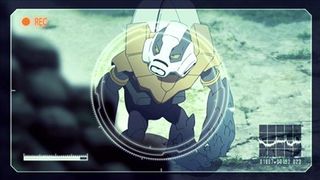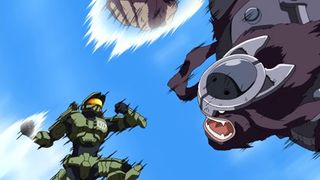GR: Let’s move on to Halo Legends.
JH: I think that the Halo universe has been developed to such an extent and is in so many different mediums now that we’re at a point that we can start to be a little bit more experimental in the way that we tell stories within the universe. Halo Legends was an interesting experiment in that. Frank and the team said, “What would happen if we took these masters of anime and set them loose in the Halo universe? Some of the stories created may be true to canon, some may absolutely not be, but regardless of that, each of these creators will bring his own unique vision to the Halo universe, and that can only be additive and interesting to the fiction.”
It’s been interesting to see these very different takes on the universe and these really focused snapshots of stories that take place within that universe at different times within the history. To me, it’s been really fascinating as a fan of Halo and a fan of anime just to see those two worlds collide.

GR: What can you tell us about the individual episodes?
FO: “The Babysitter” came out a week or two after the launch of ODST. The plan was to explain to “Spartan fans” a little bit more about the ODSTs, their inner relationship and the interplay between those guys and the Spartans. We wanted to show the relative strengths of each. The strengths of the ODST as far as the fans are concerned are teamwork and tenacity and all that stuff. Spartans tend to be thought of, maybe incorrectly in terms of the broader fiction, the Spartans are thought of as sort of singular, can do it all on their own, don’t need that kind of teamwork , and so that’s how we designed that story and that’s how we built that story in the first place.
The rest of the stuff was a lot less strategic and a lot more opportunistic, so “The Duel” for example explores the Covenant itself from an internal perspective, which you rarely get to see. The importance and the excitement that the fans have around the Elites, which I think ended up taking somewhat of an action backseat in Halo 3. I think that people enjoy fighting them and enjoy the classic matchup of Spartan versus Elite. We wanted to focus on their strengths, and the Elites have a very complicated society. We want to explore it and show that it wasn’t just as simple as good Elites and bad Elites. It has to do with the overriding politics of being part of a larger hegemonistic empire and what their role in it was, and how that role came to be.

With “The Package,” we wanted to show Spartans working as a team. How they operate as a team. More importantly, the gameplay in Halo is an FPS. It’s about shooting, individual achievement, and it’s really about gunplay. There’s driving and there’s sort of platform elements, if you think about how Halo compares to Call of Duty, in terms of what you can do, you can jump or navigate the environment in 3D. But we wanted to show that Spartans are very physical. They’re a lot more than run and gun. They’re dynamic, they’re acrobatic, and they’re incredibly strong, incredibly powerful.
The final episode to air on Waypoint is called “Origins Part One.” It absolutely and definitely explains the Halo array, the Forerunner civilization at that time, and the desperation that lead to the necessity for a weapon of last resort like that. It opens up a window into that society that people have often asked about.
“Prototype” is from Studio Bones out of Japan. They’re kind of the hottest thing in anime right now, very action focused. It’s a very action-oriented episode, it’s almost all action. There’s a human story in there, but there’s also a lot of gunplay and a lot of action. We have an episode called “Homecoming,” which deals with Spartan origins, similar to the stuff discussed in Fall of Reach.
“Origins Part Two” is the human side of the origins of the Halo universe. We go to civilization from the dawn of man after the Halo event, all the way to the last moments of Halo 3 and maybe a little bit beyond.

“Odd One Out” is off-canon. It’s got some elements that are true to the Halo universe, but I think when people watch it they’ll understand that it’s not literally part of the Halo canon. There’s definitely some fun to be had watching that. I think that the other bonus is that a lot of the other stuff is pretty violent, as violent as the videogame. This is a way that families can watch it. There’s no gun violence or death or mayhem, so I think that families will be able to get a little appreciation of Halo visuals in a different setting.
